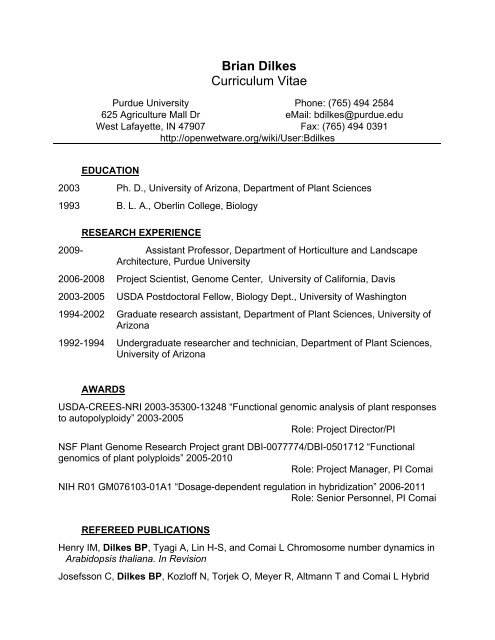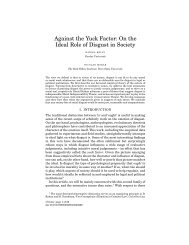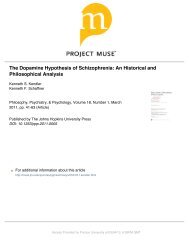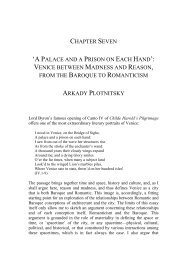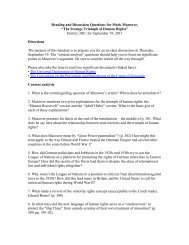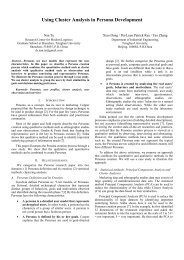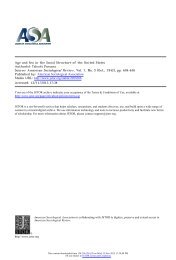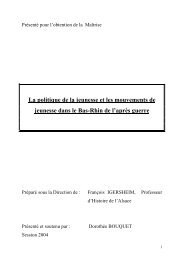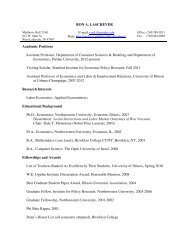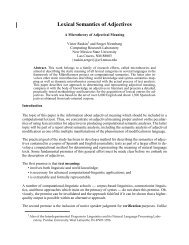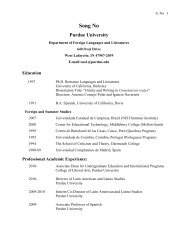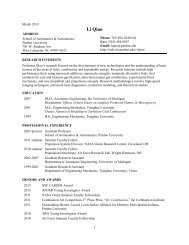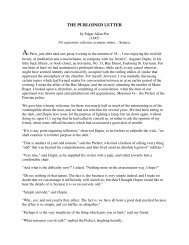Brian Dilkes Curriculum Vitae - Purdue University
Brian Dilkes Curriculum Vitae - Purdue University
Brian Dilkes Curriculum Vitae - Purdue University
Create successful ePaper yourself
Turn your PDF publications into a flip-book with our unique Google optimized e-Paper software.
<strong>Brian</strong> <strong>Dilkes</strong><br />
<strong>Curriculum</strong> <strong>Vitae</strong><br />
<strong>Purdue</strong> <strong>University</strong> Phone: (765) 494 2584<br />
625 Agriculture Mall Dr eMail: bdilkes@purdue.edu<br />
West Lafayette, IN 47907 Fax: (765) 494 0391<br />
http://openwetware.org/wiki/User:Bdilkes<br />
EDUCATION<br />
2003 Ph. D., <strong>University</strong> of Arizona, Department of Plant Sciences<br />
1993 B. L. A., Oberlin College, Biology<br />
RESEARCH EXPERIENCE<br />
2009- Assistant Professor, Department of Horticulture and Landscape<br />
Architecture, <strong>Purdue</strong> <strong>University</strong><br />
2006-2008 Project Scientist, Genome Center, <strong>University</strong> of California, Davis<br />
2003-2005 USDA Postdoctoral Fellow, Biology Dept., <strong>University</strong> of Washington<br />
1994-2002 Graduate research assistant, Department of Plant Sciences, <strong>University</strong> of<br />
Arizona<br />
1992-1994 Undergraduate researcher and technician, Department of Plant Sciences,<br />
<strong>University</strong> of Arizona<br />
AWARDS<br />
USDA-CREES-NRI 2003-35300-13248 “Functional genomic analysis of plant responses<br />
to autopolyploidy” 2003-2005<br />
Role: Project Director/PI<br />
NSF Plant Genome Research Project grant DBI-0077774/DBI-0501712 “Functional<br />
genomics of plant polyploids” 2005-2010<br />
Role: Project Manager, PI Comai<br />
NIH R01 GM076103-01A1 “Dosage-dependent regulation in hybridization” 2006-2011<br />
Role: Senior Personnel, PI Comai<br />
REFEREED PUBLICATIONS<br />
Henry IM, <strong>Dilkes</strong> BP, Tyagi A, Lin H-S, and Comai L Chromosome number dynamics in<br />
Arabidopsis thaliana. In Revision<br />
Josefsson C, <strong>Dilkes</strong> BP, Kozloff N, Torjek O, Meyer R, Altmann T and Comai L Hybrid
<strong>Dilkes</strong> CV - 2 -<br />
incompatibility in Arabidopsis is determined by a genetic network. In revision for<br />
Genetics<br />
<strong>Dilkes</strong> BP, Spielman M, Wiezbauer R, Burkart-Waco D, Watson B, Scott R, and Comai<br />
L 2008 The maternally-expressed WRKY transcription factor TTG2 controls lethality in<br />
interploidy crosses of Arabidopsis. PLoS Biology<br />
Pignatta D, <strong>Dilkes</strong> BP, Wroblewski T, Michelmore RW, Comai L 2008 Transgeneinduced<br />
gene silencing is not affected by a change in ploidy level. PLoS One<br />
Henry IM, <strong>Dilkes</strong> BP, Comai L 2007 Genetic basis for dosage sensitivity in Arabidopsis<br />
thaliana. PLoS Genet 3(4): e70 doi:10.1371/journal.pgen.0030070<br />
Henry IM, <strong>Dilkes</strong> BP, Comai L 2006 Molecular karyotyping and aneuploidy detection in<br />
A. thaliana using quantitative fluorescent PCR. Plant Journal, 48:307-319<br />
Josefsson C, <strong>Dilkes</strong> B, Comai L 2006 Parent-dependent loss of gene silencing during<br />
interspecies hybridization. Current Biology 16:1322-1328<br />
Coelho CM, Dante RA, Sabelli PA, Sun Y, <strong>Dilkes</strong> BP, Gordon-Kamm WJ Larkins BA<br />
2005 Cyclin-dependent kinase inhibitors in maize endosperm and their potential role in<br />
endoreduplication. Plant Physiology 138: 2323-36<br />
Henry IM, <strong>Dilkes</strong> BP, Young K, Watson B, Wu H, Comai L 2005 Aneuploidy and<br />
genetic variation in the Arabidopsis thaliana triploid bridge. Genetics 170: 1979-88<br />
<strong>Dilkes</strong> BP, Comai L 2004 A differential dosage hypothesis for parental effects in seed<br />
development. Plant Cell 16:3174-80<br />
Hunter BG, Beatty MK, Singletary GW, Hamaker BR, <strong>Dilkes</strong> BP, Larkins BA, and Jung<br />
R 2002 Maize opaque endosperm mutations create extensive changes in patterns of<br />
gene expression. Plant Cell 14: 14:2591-2612<br />
Gordon-Kamm WJ, <strong>Dilkes</strong> BP, Lowe KS, Hoerster G, Sun X, Ross M, Church L, Bunde<br />
C, Farrell J, Hill P, Maddock S, Snyder J, Li X, Woo Y, Bidney D and Larkins BA 2002<br />
Stimulation of the cell cycle and maize transformation by disruption of the plant<br />
retinoblastoma pathway. Proc. Natl. Acad. Sci. U S A 99: 11975-11980<br />
<strong>Dilkes</strong> BP, Dante RD, Coelho C, Larkins BA. 2002 Genetic analyses of<br />
endoreduplication in Zea mays endosperm: evidence of sporophytic and zygotic<br />
maternal control. Genetics 160: 1163-117<br />
Larkins BA, <strong>Dilkes</strong> BP, Dante RA, Coelho CM, Woo Y, Liu Y 2001 Investigating the<br />
hows and whys of DNA endoreduplication. J. Exp. Bot. 52: 183-92<br />
Sun Y, <strong>Dilkes</strong> BP, Zhang C, Dante RA, Carneiro NP, Lowe KS, Jung R, Gordon-Kamm<br />
WJ, Larkins BA 1999 Characterization of maize (Zea mays L.) Wee1 and its activity in<br />
developing endosperm. Proc. Natl. Acad. Sci. U S A 96: 4180-5<br />
Choe S, <strong>Dilkes</strong> BP, Gregory BD, Ross AS, Yuan H, Noguchi T, Fujioka S, Takatsuto S,<br />
Tanaka A, Yoshida S, Tax FE, Feldmann KA 1999 The Arabidopsis dwarf1 mutant is<br />
defective in the conversion of 24-methylenecholesterol to campesterol in<br />
brassinosteroid biosynthesis. Plant Physiol. 119: 897-907
<strong>Dilkes</strong> CV - 3 -<br />
Choe S, <strong>Dilkes</strong> BP, Fujioka S, Takatsuto S, Sakurai A, Feldmann KA 1998 The DWF4<br />
gene of Arabidopsis encodes a cytochrome P450 that mediates multiple 22alphahydroxylation<br />
steps in brassinosteroid biosynthesis. Plant Cell 10: 231-43<br />
In preparation<br />
<strong>Dilkes</strong> BP, Josefsson C, and Comai L A shared genetic network controls postzygotic<br />
lethality of both interspecies and interploidy hybrids of Arabidopsis.<br />
<strong>Dilkes</strong> BP, Henry IM, and Comai L Identification of paternal-effect QTL responsible for<br />
interploidy post-zygotic lethality in Arabidopsis.<br />
Henry IM, <strong>Dilkes</strong> BP and Comai L Phenotypic consequences of aneuploidy in<br />
Arabidopsis thaliana.<br />
<strong>Dilkes</strong> BP, Weizbauer R, and Comai L QTL for interploidy F1 lethality and seed size<br />
demonstrate independent genetic regulation of size and survival.<br />
Chang P, <strong>Dilkes</strong> BP, McMahon S, Comai L, and Nuzdin S. Contribution of cis<br />
regulatory evolution to allele specific expression in Arabidopsis allopoyploids.<br />
Walia H, Josefsson C. <strong>Dilkes</strong> BP, Kirkbride R, Harada J and Comai L. Dosagedependent<br />
deregulation of an AGAMOUS LIKE GENES cluster contributes to<br />
interspecific incompatibility.<br />
Pignatta D, <strong>Dilkes</strong> BP, Comai L. Developmental stage sensitizes the two homoeologs<br />
to hybridization in Arabidopsis<br />
RELEVANT TECHNICAL PUBLICATIONS<br />
Gordon-Kamm WJ, Lowe KS, Bailey MA, Gregory CA, Hoerster GJ, Larkins BA, <strong>Dilkes</strong><br />
B, Burnett R, Woo YM 2007 Methods of using viral replicase polynucleotides and<br />
polypeptides. U.S. Patent 7,309,813<br />
Gordon-Kamm WJ, Lowe KS, Larkins BA, <strong>Dilkes</strong> B, Sun Y 2007 Cell cycle nucleic<br />
acids, polypeptides and uses thereof. U.S. Patent 7,256,280<br />
Gordon-Kamm WJ, Lowe KS, Gregory CA, Hoerster GJ, Larkins BA, <strong>Dilkes</strong> B, Burnett<br />
R 2004 Methods of using viral replicase polynucleotides and polypeptides. U.S. Patent<br />
6,770,800<br />
Sun Y, <strong>Dilkes</strong> B, Larkins BA, Lowe KS, Gordon-Kamm WJ, Dante RA 2004 Cell cycle<br />
nucleic acids, polypeptides and uses thereof. U.S. Patent 6,777,590<br />
Gordon-Kamm WJ, Lowe KS Bailey MA, Gregory CA, Hoerster GJ, Larkins BA, <strong>Dilkes</strong><br />
B, Burnett R, Woo, Y 2002 Methods of using viral replicase polynucleotides and<br />
polypeptides. U.S. Patent 6,452,070<br />
Gordon-Kamm WJ, Lowe KS Bailey MA, Gregory CA, Hoerster GJ, Larkins BA, <strong>Dilkes</strong><br />
B, Burnett R, Woo, Y 2001 Methods of using viral replicase polynucleotides and<br />
polypeptides. U.S. Patent 6,284,947
<strong>Dilkes</strong> CV - 4 -<br />
<strong>Dilkes</strong>, BP and Larkins BA 1999 "Transgenic plants: where is this technology leading<br />
us" in Biowork II (A. Borem, M.P. Giudice and N.S. Sakiyama, eds.), Federal<br />
<strong>University</strong> of Vicosa, Vicosa, Brasil, 213-240<br />
<strong>Dilkes</strong> BP, Feldmann KA 1998 Cloning genes from T-DNA tagged mutants. Methods<br />
Mol. Biol. 82: 339-51<br />
Schulz B, Bennett MJ, <strong>Dilkes</strong> BP, and Feldmann KA 1995 “T-DNA tagging in<br />
Arabidopsis thaliana: cloning by gene disruption” in Plant Molecular Biology Manual<br />
(Gelvin, S, ed.) Kluwer Academic Publishers, The Netherlands pp. K3:1-17<br />
INVITED TALKS AND PRESENTATIONS<br />
“Genetic networks and the molecular biology of plant speciation” Botanical Society of<br />
America Meeting, Vancouver BC, 2008<br />
“Genomics of speciation in Arabidopsis” International Congress of Brassica Research,<br />
Lilehammer, Norway, 2008<br />
“The genetics of reproductive isolation” <strong>Purdue</strong> <strong>University</strong>, West Lafayette, IN, 2008<br />
“Maternal to paternal ploidy balance – effects on seed size” Translational Seed Biology<br />
Meeting, Davis CA, 2007<br />
“The interploidy hybridization barrier is controlled by a genetic network” International<br />
Conference on Polyploidy Heterosis and Epigenetics, Beijing, China, 2007<br />
“Polyploidy-regulated hybridization barriers” Plant Animal Genome Conference, San<br />
Diego, CA, 2007<br />
“Genome dosage effects in sexual hybridization barriers” Genome Center, UC Davis,<br />
Davis, CA, 2006<br />
“Dr. Strangelove, or how I learned to stop worrying and love hybridization barriers”<br />
Washington <strong>University</strong>, St. Louis, MO, 2006<br />
“Dr. Strangelove, Weapons of Mass Destruction, and the interploidy hybridization<br />
barrier” <strong>Purdue</strong> <strong>University</strong>, West Lafayette, IN, 2006<br />
“Dosage effects in interploidy crosses of Arabidopsis” Banbury Conference on Gene<br />
Dosage Polyploidy and Heterosis, Cold Spring Harbor NY, 2005<br />
“Ploidy hybridization barriers: genotype x karyotype interaction” Plant and Animal<br />
Genome Conference, San Diego, CA, 2005<br />
“Epigenetics of Arabidopsis polyploids: gene x genome interactions” Epigenetics<br />
Seminar Series Fred Hutchinson Cancer Research Center, Seattle, WA, 2004<br />
“Cell cycle regulation mediated by maize Rb1 and viral interactors” Maize Genetics<br />
Conference, Lake Geneva, WI, 2001<br />
“Cell cycle control in endoreduplicating maize endosperm” Annual meeting of the
<strong>Dilkes</strong> CV - 5 -<br />
American Society of Plant Physiology, Baltimore, MD, 2000<br />
“Zea and the art of cell cycle control” Pioneer Hi-Bred Intl., Johnston, IA, 1999<br />
TEACHING EXPERIENCE<br />
Undergraduate level<br />
Laboratory sections of PLS312 (plant genetics; two semesters), BIO181 (introductory<br />
biology for majors; two semesters), and PLS100-H (Honors introductory plant<br />
sciences; one semester) while a graduate teaching assistant at the <strong>University</strong> of<br />
Arizona.<br />
Guest lecture in Introductory Plant Sciences PLS100 H on “Water Potential,<br />
Transpiration, and Water Use Efficiency” 1997<br />
Co-taught a self defense course within the Experimental College at Oberlin College<br />
Research supervision of three undergraduates at <strong>University</strong> of Arizona, five at the<br />
<strong>University</strong> of Washington, and one at the <strong>University</strong> of California at Davis<br />
Honors Thesis advisor for Sarah Dobrozsi at the <strong>University</strong> of Washington<br />
Graduate level<br />
Guest instructor for PLB292 a seminar-style mandatory graduate course in The Section<br />
of Plant Biology at the <strong>University</strong> of California, at Davis 2007<br />
Various lectures in BIO527 a seminar-style plant molecular biology course in the<br />
Department of Biology at the <strong>University</strong> of Washington 2003-2006<br />
Lecture in BIOC533 a seminar-style minicourse on nuclear structure and organization in<br />
the Department of Biochemistry at the <strong>University</strong> of Washington Medical School 2005<br />
Research supervision of the Diplom Thesis project of Renate Weizbauer from the<br />
<strong>University</strong> of Cologne, done in Seattle 2005-2006.<br />
SYNERGISTIC ACTIVITIES and SERVICE<br />
Academic Editor for PLoS One 2006-<br />
Ad-hoc reviewer for Genetics, Genome Research, Molecular Ecology, Molecular Plant,<br />
PLoS One, The Plant Cell, Plant Physiology, The Plant Journal, Plant Molecular<br />
Biology, The New Phytologist, Trends in Plant Science, and Plant Methods.<br />
Ad-hoc reviewer for the National Science Foundation, United States Department of<br />
Agriculture, and <strong>University</strong> of Washington Royalty Research Fund (2005-2006)<br />
Founding member and Tri-Chair of the <strong>University</strong> of Washington Post-Doctoral<br />
Association 2005-2006<br />
Frequent panelist in efforts to educate graduate students about selecting high-quality
<strong>Dilkes</strong> CV - 6 -<br />
postdoctoral training opportunities. Done for the UW Graduate School, UW Biology<br />
Department and HHMI 2004-2006<br />
Co-organizer and participant in the Howard Hughes Medical Institute-sponsored<br />
workshop “Future Faculty Fellows” at the <strong>University</strong> of Washington 2004<br />
Founding member of Goober Biofuels Racing 2007-


